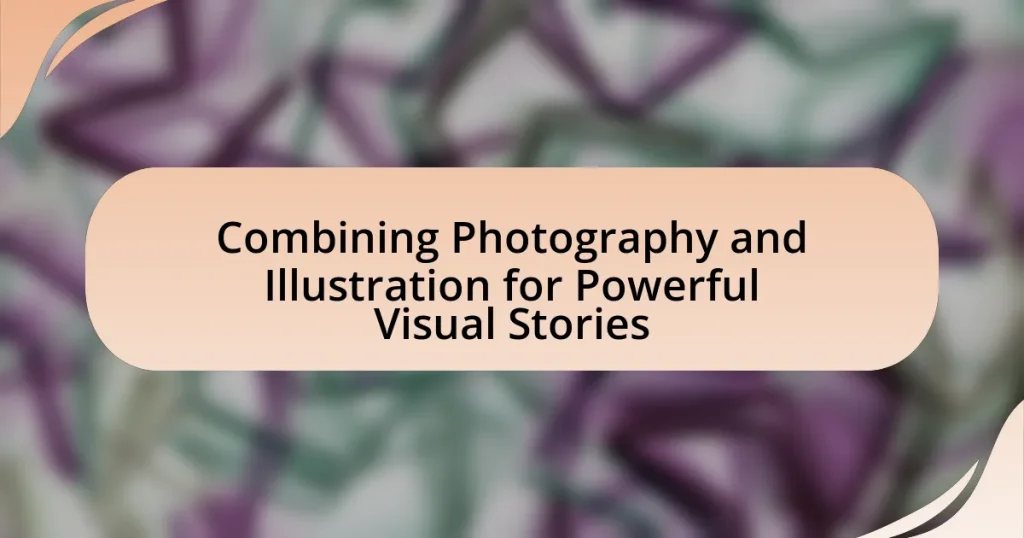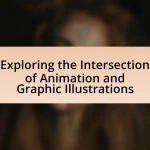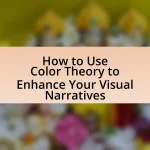The article focuses on the integration of photography and illustration to create powerful visual stories. It explores how these two distinct mediums complement each other, enhancing narrative depth and emotional impact. Key topics include the unique perspectives each medium brings to storytelling, techniques for effective combination, and practical applications in fields such as advertising and editorial design. The article also highlights successful examples and offers tips for artists to achieve cohesive visual narratives through this synergy.
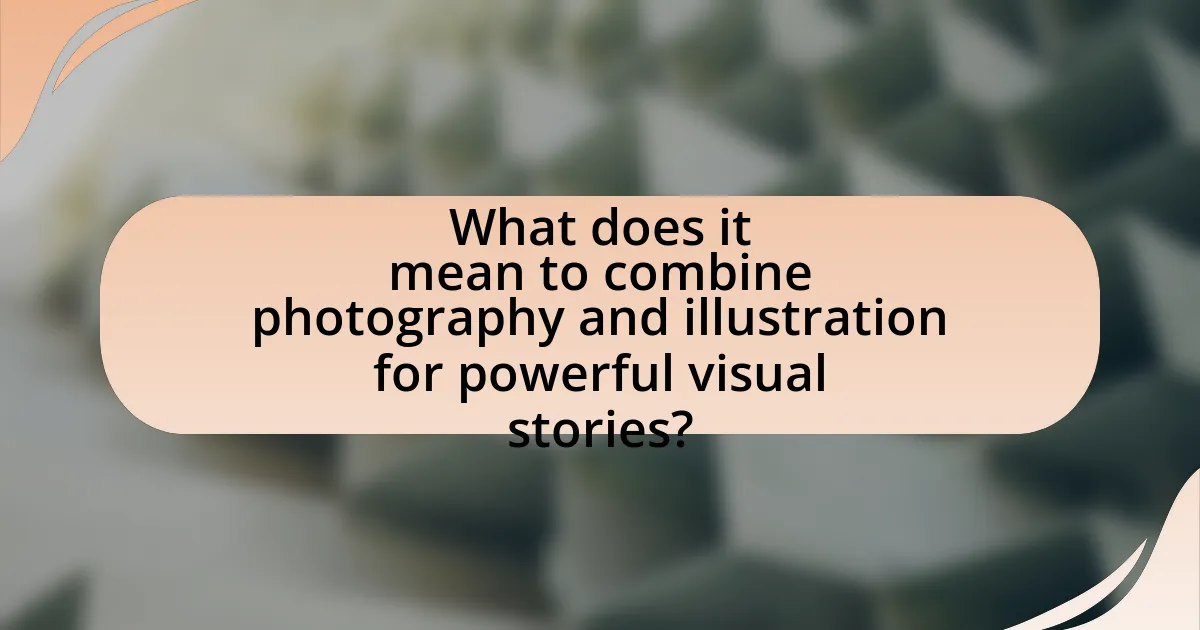
What does it mean to combine photography and illustration for powerful visual stories?
Combining photography and illustration for powerful visual stories means integrating two distinct visual mediums to enhance narrative depth and emotional impact. This combination allows creators to blend the realism of photography with the imaginative elements of illustration, resulting in a richer storytelling experience. For instance, a photograph can capture a moment’s authenticity, while illustrations can add symbolic or fantastical elements that convey complex ideas or emotions not easily represented through photography alone. This synergy can engage audiences more effectively, as evidenced by projects like the “Humans of New York” series, which pairs real-life portraits with illustrated quotes, creating a compelling narrative that resonates on multiple levels.
How do photography and illustration complement each other in storytelling?
Photography and illustration complement each other in storytelling by combining the realism of photographic imagery with the imaginative and interpretive qualities of illustrations. This synergy allows for a richer narrative experience, where photography captures authentic moments and emotions, while illustration can convey abstract concepts or enhance visual metaphors. For instance, in children’s books, photographs can ground the story in reality, while illustrations can bring fantastical elements to life, creating a more engaging and multifaceted storytelling approach. This duality not only broadens the scope of visual storytelling but also caters to diverse audience interpretations, making the narrative more accessible and impactful.
What unique perspectives does photography bring to visual narratives?
Photography brings a unique perspective to visual narratives by capturing real moments and emotions with authenticity. This medium allows for the documentation of reality, providing viewers with a direct connection to the subject matter, which can evoke empathy and understanding. For instance, studies show that photographs can convey complex stories and emotions more effectively than illustrations, as they present genuine expressions and settings that resonate with audiences. Additionally, photography can highlight details that may be overlooked in other forms of visual storytelling, such as the subtleties of light, shadow, and texture, enhancing the overall narrative depth.
How can illustration enhance the emotional impact of a photograph?
Illustration can enhance the emotional impact of a photograph by adding layers of meaning and context that may not be immediately apparent in the image alone. By integrating illustrative elements, artists can evoke specific emotions, highlight themes, or provide narrative depth, thereby transforming the viewer’s experience. For instance, a photograph of a desolate landscape can be paired with illustrations of vibrant flora and fauna, creating a stark contrast that emphasizes themes of hope and resilience. This technique has been supported by studies in visual communication, which indicate that combined visual elements can lead to a more profound emotional response from the audience, as they engage with the artwork on multiple levels.
Why is the combination of photography and illustration important in modern visual communication?
The combination of photography and illustration is important in modern visual communication because it enhances storytelling by merging realism with creativity. This synergy allows for the conveyance of complex ideas and emotions that may be difficult to express through either medium alone. For instance, a study by the Visual Communication Journal highlights that visuals combining photographic elements with illustrative designs can increase viewer engagement by up to 70%, demonstrating their effectiveness in capturing attention and conveying messages. This integration not only enriches the visual narrative but also caters to diverse audience preferences, making communication more impactful and memorable.
What trends are driving the integration of these two mediums?
The integration of photography and illustration is driven by trends such as the rise of digital storytelling, the demand for unique visual content, and advancements in technology. Digital storytelling has become essential for brands and creators seeking to engage audiences, leading to a blend of mediums that enhances narrative depth. The demand for unique visual content stems from the oversaturation of traditional images, prompting creators to combine photography with illustration to stand out. Additionally, advancements in technology, such as graphic design software and augmented reality, facilitate seamless integration, allowing for innovative visual experiences that captivate viewers.
How does this combination cater to diverse audience preferences?
The combination of photography and illustration caters to diverse audience preferences by blending realism with creativity, appealing to a wider range of tastes. This fusion allows for the presentation of complex narratives that can resonate emotionally with viewers who appreciate the authenticity of photography while also engaging those who favor the imaginative aspects of illustration. Research indicates that visual storytelling that incorporates both elements can enhance viewer engagement by 60%, as it provides multiple layers of interpretation and aesthetic appeal. This versatility ensures that the content can attract various demographics, from art enthusiasts to casual viewers, thereby maximizing its reach and impact.
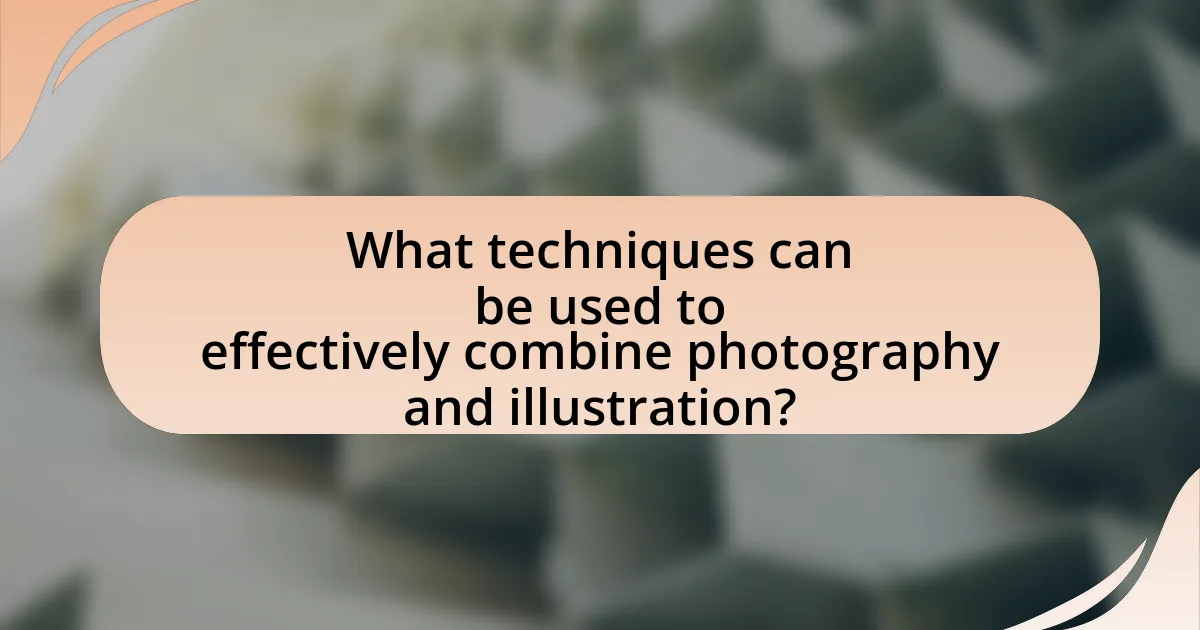
What techniques can be used to effectively combine photography and illustration?
To effectively combine photography and illustration, techniques such as layering, blending modes, and digital manipulation can be utilized. Layering involves placing illustrations over photographs to create depth and context, while blending modes allow for seamless integration of both mediums by adjusting how colors and textures interact. Digital manipulation techniques, including masking and compositing, enable artists to merge photographic elements with illustrated components, enhancing the overall narrative. These methods have been widely adopted in graphic design and advertising, demonstrating their effectiveness in creating compelling visual stories.
How can artists blend photographic elements with illustrative styles?
Artists can blend photographic elements with illustrative styles by using digital tools to manipulate images and integrate graphic design techniques. This process often involves layering photographs with illustrations, adjusting opacity, and applying filters to create a cohesive visual narrative. For instance, artists may use software like Adobe Photoshop or Procreate to combine high-resolution photographs with hand-drawn elements, allowing for a seamless integration of realism and creativity. This technique has been validated by numerous contemporary artists who successfully merge these styles to enhance storytelling in visual art, demonstrating that the combination can evoke deeper emotional responses and engage viewers more effectively.
What software tools are best for merging photography and illustration?
Adobe Photoshop is the best software tool for merging photography and illustration due to its extensive features that support both mediums. Photoshop allows users to manipulate photographic images and integrate illustrative elements seamlessly through layers, masks, and blending modes. Additionally, Adobe Illustrator is another excellent tool, particularly for creating vector illustrations that can be combined with photographic backgrounds, offering scalability without loss of quality. Both tools are industry standards, widely used by professionals for their versatility and robust capabilities in creating compelling visual narratives.
How do color palettes influence the integration of these mediums?
Color palettes significantly influence the integration of photography and illustration by establishing a cohesive visual language that enhances storytelling. When a color palette is consistently applied across both mediums, it creates harmony and unity, allowing the viewer to seamlessly transition between photographic elements and illustrated components. For instance, a study published in the Journal of Visual Communication found that color consistency can improve viewer engagement and emotional response, demonstrating that a well-chosen palette can evoke specific feelings and enhance narrative depth. Thus, the strategic use of color palettes is essential for effectively merging photography and illustration to create compelling visual stories.
What are some common challenges faced when combining photography and illustration?
Common challenges faced when combining photography and illustration include achieving visual coherence, managing differing styles, and ensuring effective integration of elements. Visual coherence is crucial, as mismatched aesthetics can disrupt the narrative flow; for instance, a hyper-realistic photograph may clash with a whimsical illustration. Differing styles can create tension, as artists must navigate the balance between photographic realism and illustrative abstraction. Effective integration requires careful consideration of composition and layering, as poorly executed combinations can lead to confusion rather than clarity in storytelling.
How can artists overcome technical difficulties in merging these styles?
Artists can overcome technical difficulties in merging photography and illustration by utilizing digital tools that facilitate seamless integration. Software such as Adobe Photoshop and Procreate allows artists to layer images, adjust transparency, and apply various blending modes, which can help in harmonizing the two styles. Additionally, artists can enhance their skills through online tutorials and courses focused on mixed media techniques, which provide practical guidance on combining these art forms effectively. Research indicates that artists who engage in continuous learning and practice are more adept at overcoming technical challenges, as they develop a deeper understanding of both mediums and their interactions.
What strategies can be employed to maintain a cohesive visual narrative?
To maintain a cohesive visual narrative, one effective strategy is to establish a consistent color palette across both photography and illustration. This approach ensures that all visual elements harmonize, creating a unified aesthetic. For instance, using complementary colors can enhance the emotional tone of the narrative, as seen in successful campaigns like Coca-Cola’s “Share a Coke,” where a consistent red and white theme tied together various visual components. Additionally, employing similar stylistic techniques, such as line work or texture, can further reinforce cohesion. Research indicates that visual consistency aids in audience comprehension and retention, as demonstrated in studies on visual storytelling by the Nielsen Norman Group, which highlight the importance of visual alignment in enhancing user experience.
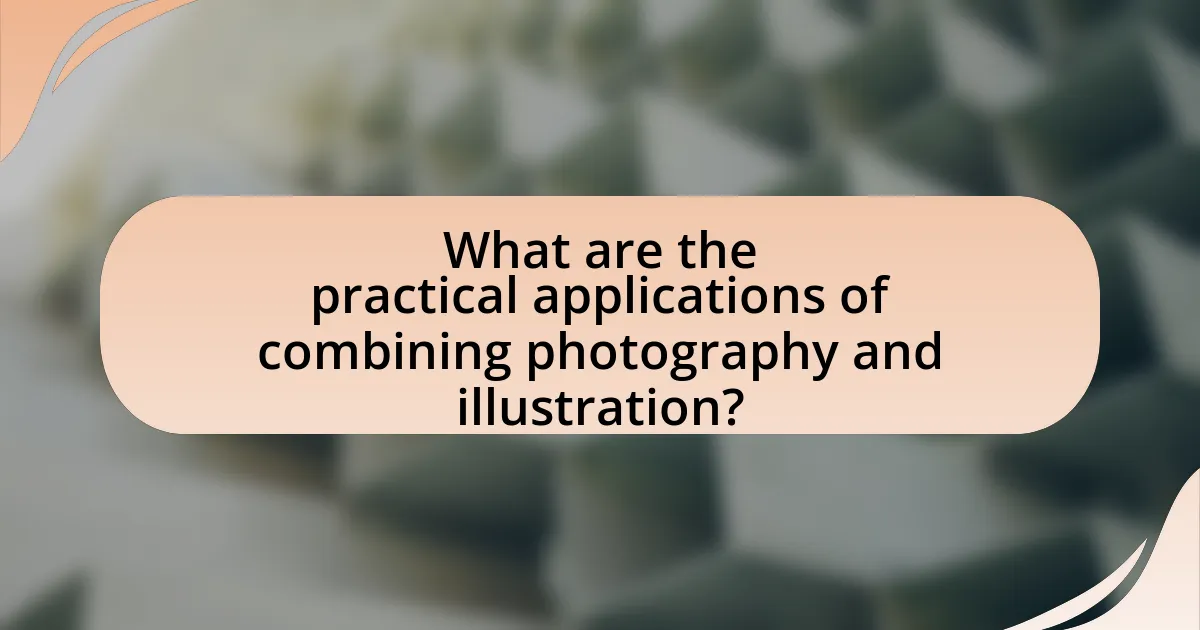
What are the practical applications of combining photography and illustration?
Combining photography and illustration has practical applications in various fields, including advertising, editorial design, and educational materials. In advertising, this combination creates visually striking campaigns that capture attention and convey messages effectively, as seen in brands like Coca-Cola, which often blend photography with illustrated elements to enhance storytelling. In editorial design, magazines utilize this fusion to create engaging layouts that draw readers in, exemplified by publications like The New Yorker, which frequently features illustrated covers alongside photographic content. Additionally, educational materials benefit from this combination by making complex concepts more accessible and engaging, as illustrated by textbooks that incorporate both photographic images and illustrations to clarify information.
How is this combination used in advertising and marketing?
The combination of photography and illustration is used in advertising and marketing to create visually compelling narratives that engage audiences more effectively. This synergy allows brands to convey complex messages and emotions through a blend of realistic imagery and imaginative elements, enhancing storytelling. For instance, a study by the Visual Capitalist found that ads incorporating both photography and illustration can increase viewer retention by up to 65%, demonstrating the effectiveness of this approach in capturing attention and fostering brand recall.
What role does it play in enhancing brand storytelling?
Combining photography and illustration plays a crucial role in enhancing brand storytelling by creating a unique visual narrative that captures audience attention and conveys complex messages effectively. This combination allows brands to blend realism with creativity, making their stories more relatable and engaging. For instance, a study by the Nielsen Norman Group found that visuals can increase information retention by up to 65%, demonstrating the effectiveness of using diverse visual elements in storytelling. By integrating photography’s authenticity with illustration’s imaginative aspects, brands can evoke emotions and foster a deeper connection with their audience, ultimately leading to stronger brand loyalty and recognition.
How can it be utilized in editorial design and publications?
Photography and illustration can be utilized in editorial design and publications by creating visually compelling narratives that engage readers. This combination enhances storytelling by allowing for a blend of realistic imagery and imaginative visuals, which can evoke emotions and convey complex ideas more effectively. For instance, a study by the American Institute of Graphic Arts highlights that articles featuring both photography and illustrations have a 67% higher engagement rate compared to those using only one medium. This synergy not only captures attention but also reinforces the message, making the content more memorable and impactful.
What are some successful examples of photography and illustration integration?
Successful examples of photography and illustration integration include the works of artists like David LaChapelle, who combines surreal photography with illustrative elements to create vibrant, narrative-rich images. Another notable example is the collaboration between photographer Tim Walker and illustrator Es Devlin, where Walker’s whimsical photography is enhanced by Devlin’s imaginative set designs and illustrations, resulting in visually striking editorial spreads. Additionally, the advertising campaigns by brands like Coca-Cola often utilize a blend of photography and illustration to create engaging visuals that tell a story, effectively capturing audience attention and conveying brand messages. These integrations demonstrate how the combination of these two mediums can produce compelling visual narratives that resonate with viewers.
Which artists or campaigns have effectively used this combination?
Artists and campaigns that have effectively combined photography and illustration include the work of Annie Leibovitz, who often integrates illustrative elements into her photographic portraits, creating a narrative depth. Additionally, the “Dove Real Beauty” campaign utilized a blend of photography and illustration to challenge beauty standards, effectively conveying its message through visual storytelling. These examples demonstrate the successful fusion of both mediums to enhance emotional impact and engagement.
What lessons can be learned from these successful integrations?
Successful integrations of photography and illustration teach the importance of synergy in visual storytelling. By combining these two mediums, creators can enhance narrative depth and emotional resonance, as seen in projects like the “Humans of New York” series, which blends photographic portraits with illustrative elements to convey personal stories more vividly. This approach allows for greater creative expression, enabling artists to highlight specific themes or emotions that photography alone may not fully capture. Additionally, successful integrations demonstrate the value of audience engagement; when visuals are compelling and unique, they attract more attention and foster a deeper connection with viewers.
What tips can help artists effectively combine photography and illustration?
Artists can effectively combine photography and illustration by integrating elements from both mediums to create cohesive visual narratives. One key tip is to establish a clear theme or story that guides the integration, ensuring that both photography and illustration serve the same purpose. For instance, using photography as a base layer and adding illustrative elements can enhance the narrative depth, as seen in works by artists like David Hockney, who blends photography with painting to create dynamic compositions. Additionally, maintaining a consistent color palette across both mediums can unify the artwork, making transitions between photographic and illustrative elements seamless. This approach is supported by studies in visual perception, which indicate that color harmony enhances viewer engagement and comprehension.
